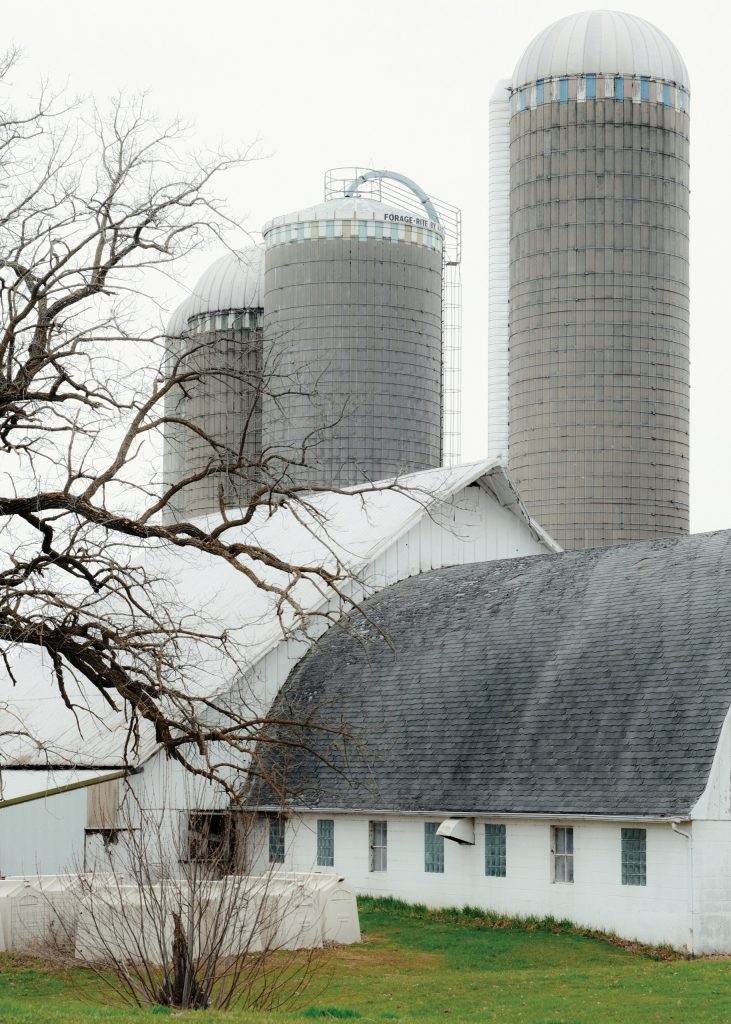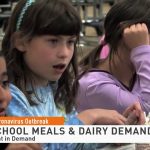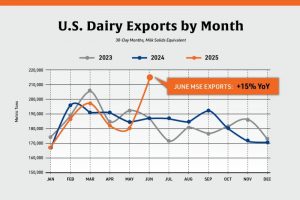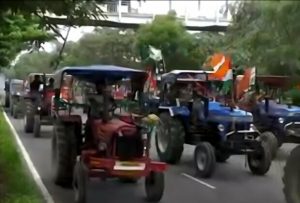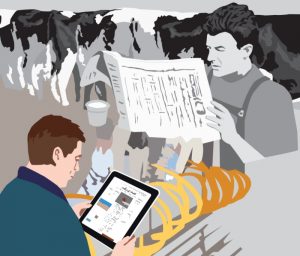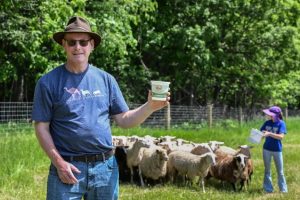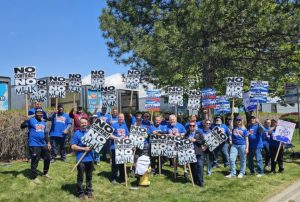
Last October, Jerry Volenec, a dairy farmer from southwestern Wisconsin, took the morning off to go to Madison for the World Dairy Expo, an annual cattle-judging contest and trade show. Volenec wanted to hear a town-hall discussion led by Sonny Perdue, Donald Trump’s Secretary of Agriculture, to learn how the Administration planned to address the economic crisis gripping Wisconsin’s family dairy farmers.
Volenec’s farm sits atop Bohemian Ridge, a jagged plateau named for the Czech immigrants who settled there in the late nineteenth century. Among them was Joseph Volenec, Jerry’s great-great-grandfather, who established the farm, in 1897. In the nineteen-fifties and sixties, Volenec’s grandfather milked a herd of sixteen cows; he could make a living because New Deal policies used price supports and other measures to boost farmers’ earnings and limit overproduction.
Jerry Volenec always wanted to become a farmer. “You couldn’t keep me out of the barn,” he said. “I was milking cows by myself by the time I was fourteen.” By the early nineties, when Volenec began farming full time, the New Deal policies had largely been dismantled. The family increased its herd to about seventy, and Volenec’s father started paying him a salary, enough money for his education at the University of Wisconsin-Platteville, and to start an I.R.A. In 2000, Volenec installed a milking parlor, and since then he has increased the herd to three hundred and thirty cows. “We’re the biggest of the small guys,” Volenec, who is forty-five, with a sturdy build and a thin goatee, said. “But I was making more money, doing less work, when I started, twenty-five years ago. I’m basically paying myself living expenses now.”
Five years ago, the price of milk fell precipitously, accelerating the long unravelling of rural Wisconsin. Since 2010, the population in two-thirds of the state’s rural counties has decreased, leading to a shrinking workforce, fewer jobs and businesses, and slower income growth rates than in metro counties. More than seventy rural schools have closed, and for the past three years the state has led the country in family-farm bankruptcies. “The level of desperation and lack of hope in our phone calls has increased,” Angie Sullivan, who supervises caseworkers at the Wisconsin Farm Center, part of the state’s Department of Agriculture, said. “Dairy farmers are working on their fifth year of low milk prices. Many banks have stopped loaning them money.” Wisconsin has seven thousand dairy farms, roughly half the number that it had a decade ago. Yet the number of cows has remained constant, because of consolidation and the proliferation of factory dairy farms, some of which have herds of more than five thousand cows.
“It’s like a never-ending cycle, almost like a hamster on the wheel,” Travis Tranel, a Republican state representative from Cuba City, forty miles south of Volenec’s farm, told me. Tranel is an organic dairy farmer with a five-hundred-cow herd. “You just keep running and running. Your only option is to produce more.” Tranel said that consolidation has all but wiped out small dairy farms in Wisconsin and now threatens medium-sized farms such as his. “We can see the future if we stay on the path we’re on,” he said, noting that the consolidation of hog farming had already transformed Iowa. “I definitely do not want to see rural Wisconsin become as empty as rural Iowa.”
After the town hall, Perdue took questions from reporters, one of whom asked if the state’s loss of small farms was inevitable. “In America, the big get bigger, and the small will go out,” Perdue said. “I don’t think in America for any small business we have a guaranteed income or guaranteed profitability.” Volenec wasn’t surprised by Perdue’s answer. “I walked in there knowing that’s how they felt,” Volenec told me, referring to the Trump Administration. “The part that was unnerving to me was that he said it to our faces. They’re not trying to hide it anymore. They’re telling us flat out: You’re not important.”
In 2016, after voting for Barack Obama twice, Volenec voted for Trump. Volenec had grown disenchanted with Obama after his Administration banned whole milk from schools and did little to slow the loss of family farms. “I wasn’t following politics closely,” he said. “I never listened to Trump give a speech, just commentary over the radio. I had the general impression that what’s wrong with the agricultural economy was that too many politicians were involved, and that having a businessman in the White House would benefit me.”
As rural Wisconsin’s fortunes have declined, its political importance has grown. Trump won the state by less than twenty-three thousand votes. If the 2020 election is close, Trump could lose Michigan and Pennsylvania—the other Rust Belt states he flipped in 2016—and still win a second term by holding Wisconsin. Trump underperformed in the suburban counties of Milwaukee, the Republican Party’s stronghold, while overperforming in the state’s rural areas, where he won nearly two-thirds of the vote. The Milwaukee Journal Sentinel found that the largest shift in voting between Obama’s seven-point victory in Wisconsin, in 2012, and Trump’s one-point win came in communities that cast fewer than a thousand votes. (Nationally, Trump won sixty-two per cent of the rural vote.)
Four years ago, Trump promised to reverse the economic decline of family farmers. “Hillary Clinton wants to shut down family farms just like she wants to shut down the mines and the steelworkers,” he said, during a campaign stop at the Iowa State Fairgrounds. “We are going to end this war on the American farmer.” In early 2018, he launched a series of trade wars, which provoked China, Mexico, Canada, and the European Union into imposing penalties on American dairy products. Mexico, the largest importer of Wisconsin cheese, levied a twenty-five-per-cent tariff on American cheeses. Last summer, Trump allotted fifteen billion dollars in compensation to farmers, but the vast majority of it has gone to the largest farms. In a tweet, he called farmers “great patriots” and promised that they would eventually be better off.
In June, as Trump’s poll numbers dropped nationwide, the Washington Post reported that his campaign advisers were losing hope for Michigan and Pennsylvania, and would focus on holding Wisconsin. “It’s baked into the cake that Trump will lose the state’s large metro areas in a landslide, while the suburbs have been fleeing him,” Ben Wikler, the head of the Wisconsin Democratic Party, told me. “Trump can’t win a second term unless he racks up enormous margins in rural Wisconsin.”
For Volenec, Trump’s appeal vanished almost immediately. “If I had known the things I know about him now, I wouldn’t have voted for him,” he said, when I visited him at his farm in February. As Trump’s trade wars escalated, Volenec’s problems worsened. In March, 2018, Canada effectively cut off all dairy imports from the United States, and milk from Michigan that had previously been exported began flooding into Wisconsin’s processing plants. The co-op where Volenec sent his milk for processing was now competing with cheap out-of-state milk, and put a cap on the amount that it would take from him. That week, Volenec heard about a meeting of the Wisconsin Farmers Union, a family-farm advocacy group, in nearby Dodgeville, to promote a version of supply management, a system used in Canada that sets a quota on the production of dairy, eggs, and poultry. Designed, like the New Deal policies, to prevent overproduction and to guarantee farmers a stable income, the system relies on higher prices for Canadian consumers. Trump’s trade war with Canada is aimed at dismantling supply management, which has long been deplored by Republican politicians. John Boehner, the former Speaker of the House, called it “Soviet-style” agriculture. For Volenec, it was a revelation. “This was my first glimpse into a world where the dairy farmer is not subservient to The Market,” he wrote in an essay called “Groomed for Apocalypse.”
Volenec lives on the farm with his wife, Jennifer, and their four daughters. His parents still live and work there, too, and the family employs four farmhands, Mexican immigrants who milk the cows three times a day, in five-hour shifts. Volenec spends most of his time feeding cattle and doing maintenance. His workday begins at five in the morning and, in the spring and summer, ends at nine or ten at night. It was bitterly cold the day I visited, so Volenec led me into a small office adjacent to the milking parlor. On the wall was a whiteboard with numbers detailing the farm’s milk production, which averages roughly thirty thousand pounds a day. A truck picks up the milk every day and takes it to the co-op, where it is turned into cheese. (Ninety per cent of Wisconsin’s milk is used to make cheese; if the state were a country, it would be the fourth-largest cheese-producing nation in the world.)
Dairy farmers have felt the effects of the coronavirus pandemic acutely. As schools and restaurants closed, they abruptly cancelled their contracts with milk bottlers and cheese factories. The price of milk dropped by more than thirty per cent, and some processors began asking their farmers to dump milk. By late April, as hungry people lined up at food banks, one farm had already dumped more than five million pounds of milk, according to “The Mid-West Farm Report.” Mitch Breunig, a dairy farmer in Sauk City, had to dump all of his morning milking for ten days. “We took a hundred-and-fifty-foot hose and ran it from the milking parlor right into the manure-storage unit in the barn,” he told me. Breunig wound up dumping eighty thousand pounds of milk, for which he received no money. “I would just look at it and think, Wow, everything we did was for nothing.”
State agencies issued protocols for dumping milk, which can pollute groundwater and decimate fish populations. Though Volenec has not had to dump any of his milk, he’s been worrying about the environmental costs of large-scale dairy farming, from water contamination to climate change. Manure runoff from industrial dairy farming has contributed to a dramatic increase in bacteria and nitrates in the state’s groundwater, according to a study funded in part by Wisconsin’s Department of Natural Resources. (A farm with twenty-five hundred cows produces as much waste as a city of four hundred thousand people.) The E.P.A. recently sampled the groundwater in a thirty-mile area of Juneau County that’s dense with dairy cows and found that sixty-five per cent of the sites had elevated levels of nitrates, which have been linked to birth defects, colon cancer, and “blue-baby syndrome,” a condition that reduces oxygen in an infant’s blood and can be fatal.
“You’re now looking at three or four generations of depletion,” Curt Meine, an environmental historian at the University of Wisconsin-Madison, told me. “Depletion of rural communities, rural landscapes, rural soils and water, depletion of the land and local economies. And you have the brain drain that followed it. This is why we have this deep urban-rural divide. We have concentrated and exported the wealth. Everyone sees it, but neither party has wrestled with it. One party exploited it, the other party has ignored it.”
“It’s hard, because I’ve built my life around a system that I believe now is extremely problematic from an environmental, social, even a personal level,” Volenec said. “It’s not the farming that I was brought up with. It’s not really even farming anymore. It’s mining. We’re extracting resources and shipping them away, and they’re not coming back. There’s no cyclical nature to it. It’s a straight line out.”
Volenec and I walked across the road to see his great-great-grandfather’s homestead. The land begins behind his house. Rolling fields stretched to the horizon, punctuated by cornstalks and a few trees. Volenec told me that he will be the family’s last farmer. “I don’t want my kids doing what I’m doing,” he said. He gazed at the snow-covered plot. “The flip side for me is: Is what I’ve done worth anything?”
Volenec’s farm is in the Driftless Area, a vast region of hills and valleys in southern and western Wisconsin whose agricultural and political histories are deeply entwined. The Driftless Area, with its steep coulees and sandstone bluffs, is a geological anomaly in the Midwest. (It also encompasses smaller portions of Iowa, Minnesota, and Illinois.) As rural America trended Republican, it remained one of the few rural regions that still tended to vote Democratic. The Driftless Area was where Aldo Leopold, the father of wildlife ecology and a professor at the University of Wisconsin-Madison, worked on soil- and watershed-restoration projects. In 1945, when Wisconsin had about a hundred and fifty thousand dairy farms, Leopold wrote an essay called “The Outlook for Farm Wildlife,” which warned of the dangers of industrialized agriculture for soil, animals, and rural communities. Leopold saw two possibilities for American agriculture: the farm as a “place-to-live,” where wildlife could be accommodated, or the farm as a “food-factory,” whose only goal is to produce sellable goods. The latter, he believed, generated “new insecurities, economic and ecological, in place of those it was meant to abolish.”
After the Second World War, American agriculture moved toward Leopold’s darker possibility. Companies such as Dow Chemical and DuPont began repurposing wartime technology and materials for agricultural uses. Nitrogen, an essential element in TNT and other explosives, was used to make fertilizers that can vastly improve yields. Such fertilizers soon became widespread, leading to the Green Revolution, which brought an enormous increase in agricultural production in the developing world. It helped reduce hunger, but also diminished biodiversity and left lasting environmental damage—depleting the soil, increasing greenhouse-gas emissions, and contaminating water supplies. In the U.S., synthetic fertilizers were essential to what’s known as the “cheap food policy,” in which the U.S.D.A. pursues ever-higher yields to keep food prices low for consumers, at the expense of farmers’ wages and the environment.
Decades before Sonny Perdue, Earl Butz, the Secretary of Agriculture under Richard Nixon, urged American farmers to “get big or get out.” Butz called farming “a big business,” and told farm audiences that they needed to “adapt or die.” In the summer of 1972, after experiencing crop failure, the Soviet Union bought eleven million tons of American grain. The sale wiped out American grain reserves, helped create a worldwide food shortage, and contributed to a rise in global food prices of more than thirty per cent. Butz implored farmers to plant “fencerow to fencerow,” promising them limitless exports. New Deal policies had encouraged soil-conservation measures, but Butz’s export-driven focus led to monoculture farming, which transformed much of the rural Midwest into endless fields of corn and soybeans. Agricultural exports became an instrument of foreign policy. “Food is a weapon,” Butz told Time in 1974, as a wave of famines spread around the world. “It is now one of the principal tools in our negotiating kit.”
In the early eighties, however, a grain embargo against the Soviet Union, a strong dollar, and a global economic recession caused exports to dry up. Many farmers, who had borrowed heavily to expand, were foreclosed on. The signing of NAFTA, in 1993, by Bill Clinton, promised a revival of exports but ended up hurting family farmers, encouraging consolidation with large agribusiness companies that, like their counterparts in the auto industry, started moving production to Mexico. Since nafta’s passage, more than two hundred thousand small farms in the U.S. have gone under, and an agricultural trading surplus with Canada and Mexico has become a twelve-billion-dollar deficit.
Because the topography of the Driftless Area made large corporate farms less tenable, the region has until recently resisted many of these trends. It has one of the highest concentrations of organic farms in the country, an enduring culture of local coöperatives established by Scandinavian immigrants, and a tradition of economic populism. The partisan tilt of the Driftless Area is a major reason that Wisconsin, prior to Trump, had not voted for a Republican for President since 1984. In 2008, Obama won Wisconsin by fourteen points and carried all the Driftless Area’s twenty-two counties.
Since the financial crash of 2008, however, the region’s economic decline has accelerated, driving political changes that may determine the next President. In 2010, Scott Walker, a Republican, won his first term as governor, capturing almost all the Driftless Area. Before his inauguration, he began appealing to—and stoking—resentment. “We can no longer live in a society where the public employees are the haves and taxpayers who foot the bills are the have-nots,” he said. Then, in February, 2011, he announced a law that gutted collective-bargaining rights for public employees and reduced their health-insurance and pension benefits. The law, which became known as Act 10, led to protests at the state capitol that at times drew a hundred thousand people.
Katherine Cramer, a political scientist at the University of Wisconsin-Madison, spent eight years interviewing rural Wisconsinites for her book “The Politics of Resentment,” published months before Trump’s election. “I heard so many complaints about teachers,” she told me. “ ‘How is it that they can get off of work? People who really work hard don’t have time to go out and protest.’ ” Act 10 prompted a recall petition, which gathered more than a million signatures, but Walker won the recall election, nearly sweeping the Driftless Area. He was reëlected two years later, with strong support from the region. In 2012, Walker announced a plan to increase Wisconsin’s milk production to thirty billion pounds a year by 2020. The goal was met four years early, but the increase contributed to a collapse in prices and the further consolidation of dairy farming.
Compounding the economic anxiety, a month before the 2016 Presidential election, Wisconsinites learned that their Obamacare rates would increase by an average of sixteen per cent. Rural residents were hit particularly hard, because they are less likely to have employer-sponsored health insurance. Trump seized on the underlying discontent, staging five large rallies in Wisconsin during the campaign, one of them in Eau Claire, which borders the Driftless Area. Two days before Election Day, he held a rally in Minneapolis, whose television market covers a large swath of western Wisconsin.
Hillary Clinton was the first candidate of either party not to campaign in Wisconsin since Richard Nixon in 1972. But Clinton’s negligence was not the only advantage Trump enjoyed. In 2011, Walker had signed one of the strictest voter-I.D. laws in the country, which was blocked by the courts until shortly before the 2016 election. A survey conducted by political scientists at the University of Wisconsin-Madison estimated that, of people in two of the state’s largest and most heavily Democratic counties who were eligible to vote but didn’t, ten per cent had been deterred by the law. Trump also benefitted from the growth and reach of right-wing media. Researchers at the University of Wisconsin-Madison found that, by 2016, Wisconsin was being blanketed by conservative talk radio, averaging nearly two hundred hours a day statewide. At the same time, traditional reporting is dying. In 2000, there were twenty-one full-time reporters covering state politics. Today, there are five.
Trump won almost all the counties in the Driftless Area, but the 2018 midterms proved that Wisconsin was not yet a one-party state. Tony Evers, the state’s superintendent of schools, defeated Walker by twenty-nine thousand votes, and Democrats won every statewide office. Evers’s victory was driven by high turnout in Milwaukee and Madison, but also by better results in rural Wisconsin, including in the Driftless Area, where he won nearly half the counties. Evers, who grew up in Plymouth, a small town an hour north of Milwaukee whose motto is “Cheese capital of the world,” campaigned heavily in farm country. “People in rural Wisconsin care about schools, health care, and good roads as much as anybody else,” Evers told me. “Wisconsin is the linchpin for both parties. If a candidate can make inroads in rural Wisconsin, they will definitely win.”
